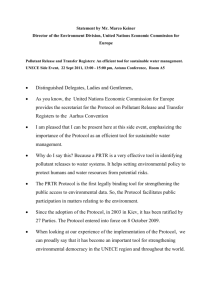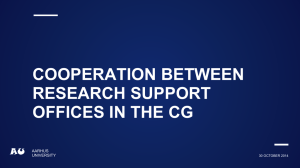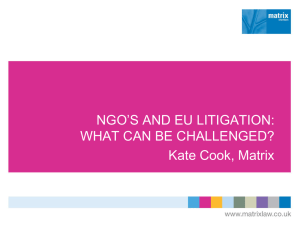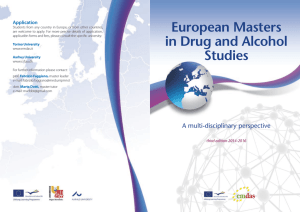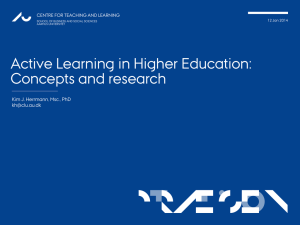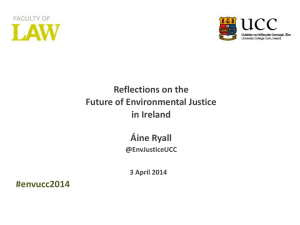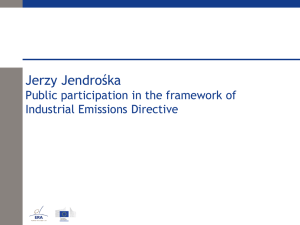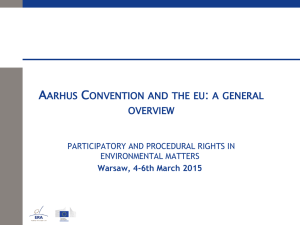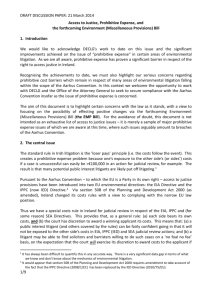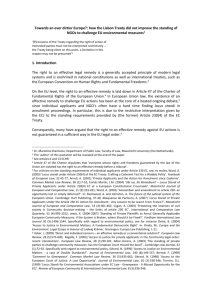A Compliance Mechanism under the UNECE Protocol on Pollutant
advertisement
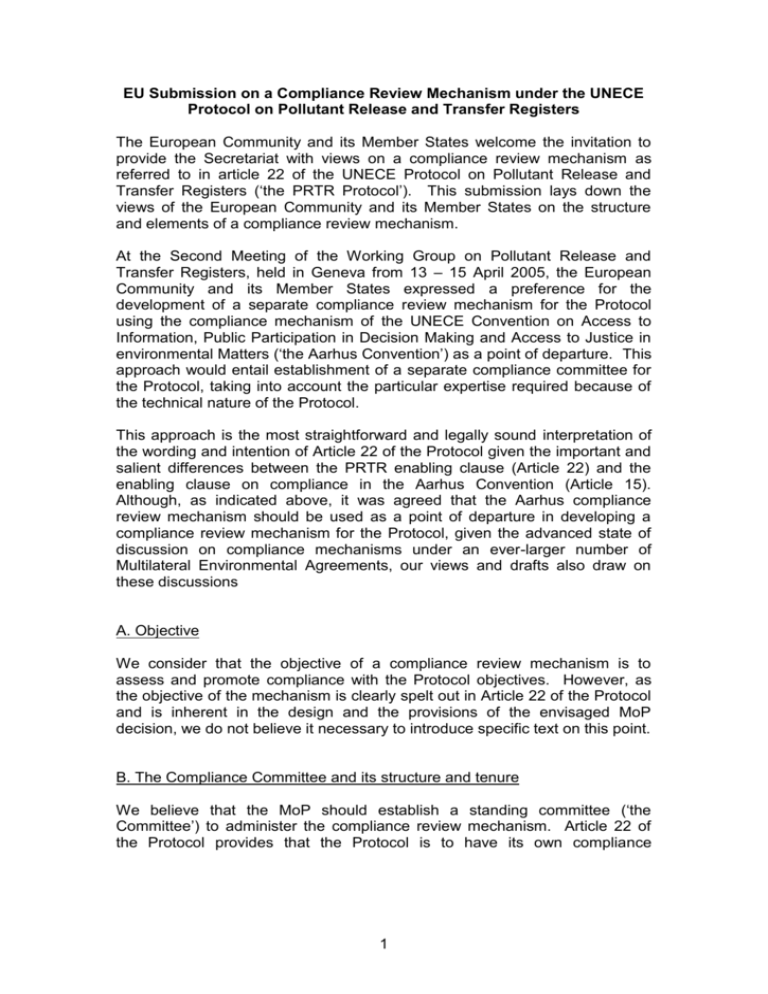
EU Submission on a Compliance Review Mechanism under the UNECE Protocol on Pollutant Release and Transfer Registers The European Community and its Member States welcome the invitation to provide the Secretariat with views on a compliance review mechanism as referred to in article 22 of the UNECE Protocol on Pollutant Release and Transfer Registers (‘the PRTR Protocol’). This submission lays down the views of the European Community and its Member States on the structure and elements of a compliance review mechanism. At the Second Meeting of the Working Group on Pollutant Release and Transfer Registers, held in Geneva from 13 – 15 April 2005, the European Community and its Member States expressed a preference for the development of a separate compliance review mechanism for the Protocol using the compliance mechanism of the UNECE Convention on Access to Information, Public Participation in Decision Making and Access to Justice in environmental Matters (‘the Aarhus Convention’) as a point of departure. This approach would entail establishment of a separate compliance committee for the Protocol, taking into account the particular expertise required because of the technical nature of the Protocol. This approach is the most straightforward and legally sound interpretation of the wording and intention of Article 22 of the Protocol given the important and salient differences between the PRTR enabling clause (Article 22) and the enabling clause on compliance in the Aarhus Convention (Article 15). Although, as indicated above, it was agreed that the Aarhus compliance review mechanism should be used as a point of departure in developing a compliance review mechanism for the Protocol, given the advanced state of discussion on compliance mechanisms under an ever-larger number of Multilateral Environmental Agreements, our views and drafts also draw on these discussions A. Objective We consider that the objective of a compliance review mechanism is to assess and promote compliance with the Protocol objectives. However, as the objective of the mechanism is clearly spelt out in Article 22 of the Protocol and is inherent in the design and the provisions of the envisaged MoP decision, we do not believe it necessary to introduce specific text on this point. B. The Compliance Committee and its structure and tenure We believe that the MoP should establish a standing committee (‘the Committee’) to administer the compliance review mechanism. Article 22 of the Protocol provides that the Protocol is to have its own compliance 1 procedure, as opposed to applying the Aarhus procedure mutatis mutandis1. Since the Protocol calls for its own compliance procedure, the prima facie legal implication is that it will also establish a compliance committee to administer the procedure. This Committee should be separate to, and distinct from, the compliance committee established under the Aarhus Convention. This is the most straightforward and legally sound interpretation of the wording and intention of Article 22 of the Protocol and reflects the ‘open’ nature of the Protocol. Synergies should be pursued by means of practical working relations between the PRTR and Aarhus compliance review bodies, as suggested at section K below. In order to work efficiently and be cost-effective, the Committee should comprise a relatively small number of experts, bringing together technical and legal expertise relevant to the subject matter of the PRTR Protocol. The Aarhus compliance review Committee has eight members, and the same number may be appropriate in respect of the PRTR Protocol, although consideration should be given as to whether it would be appropriate to have an even number of members so a decision could always be reached. The experts, who should act in their individual capacity, should be nominated by Parties and elected by the MoP. Due consideration should be given to an equitable geographical distribution in electing the members. There should be a system of staggered terms of office, to guarantee a good mixture of fresh thinking as well as the necessary continuity in the process. C. Meetings of the Compliance Committee The Committee should meet as often as necessary to fulfil its functions, but at least once a year unless otherwise decided, taking into account the meeting schedules of the MoP and other relevant bodies under the Protocol and the Aarhus Convention. Special provisions on voting are not necessary. This should be set out in detail in the Rules of Procedure, which apply to subsidiary bodies including the Compliance Committee. D. Functions of the Compliance Committee The Committee should have the function to assess and secure compliance with the provisions of the Protocol and to address cases of non-compliance. The Committee should be enabled to decide as much as possible on its level in order to provide for timely response and to avoid politicisation of cases of non-compliance at the level of the MoP. The Committee should be empowered to examine, inter alia: (i) specific cases of actual or potential non-compliance by individual Parties; 1 In contrast, see Article 14, paragraph 6, of the SEA Protocol to the Espoo Convention, which provides that the Parties at their first meeting “shall consider and adopt the modalities for applying the procedure for the review of compliance with the Convention to this Protocol.” 2 (ii) general compliance problems, such as systemic or recurring problems; and (iii) general and specific consideration of reporting obligations. E. Secretariat The secretariat referred to in Article 21 of the Protocol should be the secretariat of the Committee. F. Initiation of the procedures and procedural safeguards A. Initiation of Procedures The MoP decision on the compliance review mechanism should spell out who can initiate the process and bring matters to the attention of the Committee (‘triggering’). Bearing in mind the final sentence of Article 22 of the Protocol, and noting the differences with Article 15 of the Aarhus Convention, we believe that self-trigger procedures, party-to-party procedures, referrals by the secretariat and the Committee itself are appropriate due to the nature of the Protocol. As regards public involvement in the compliance review mechanism, it is fully acknowledged that Article 22 of the Protocol is less prescriptive than Article 15 of the Aarhus Convention, in terms both of whether the public should be involved and the degree of their involvement. It is also important for the Committee to be able to consider information from all sources that it considers to be relevant. B. Procedural Safeguards The European Community and its Member States regard it as necessary that procedural safeguards are incorporated to prevent any possible abuse of the compliance review mechanism. Clear and sufficient procedural safeguards must include provisions on: the need for submissions to be supported by corroborating information; the opportunity for Parties concerned to make representations; clear time-limits for procedural steps to make the process predictable; the possibility for the committee to exclude ill-founded submissions and de minimis cases; the possibility for the committee to base its considerations on information from all sources it considers relevant, including information provided by the public; and the handling of confidential information. C. Confidentiality 3 The handling of information under the compliance review mechanism should be based on the principle of openness with confidentiality as an exception. The European Community and its Member States believe that the issue of confidentiality requires careful consideration in the context of the compliance procedure. It is not appropriate in this context to refer to article 12 of the Protocol, which concerns the confidentiality of certain information contained in a pollutant release and transfer register. Neither should the PRTR compliance review mechanism cross-refer to the Aarhus Convention. Consideration should therefore be given as to whether the exceptions provided for in article 4(4) of the Aarhus Convention should therefore be set out in full with appropriate amendments to take account of the nature of the Protocol. G. Report on the Activities of the Committee The Committee should submit a report on its activities to each ordinary meeting of the Parties. The report should be made available to the public. H. General issues of compliance Besides dealing with specific issues of non-compliance, the Committee should also have the function to examine general compliance issues in the context of the Protocol. I. Measures regarding non-compliance Regarding the treatment of Parties found to be in non-compliance, the compliance review mechanism should provide for a wide range of possible measures that gives the flexibility to react, as appropriate, taking into account such factors as the cause, type, degree, duration and frequency of noncompliance. A combination of facilitative and additional / stronger measures should be considered. The measures should be described as accurately as possible, leaving space for flexibility with regard to facilitative measures. The measures should range from the provision of advice to stronger measures. All measures should be in accordance with international law. J. Relationship between settlement of disputes and compliance procedure Compliance procedures differ fundamentally from dispute settlement procedures. Compliance review mechanisms are non-adversarial, forward looking and involve multilateral interests, while dispute settlement is adversarial, backward looking and involves bilateral interests. The compliance procedure would not, therefore, prejudice the dispute settlement procedure under the Protocol. 4 K. Enhancement of Synergies The European Community and its Member States support the consideration of possible synergies and linkages, including through organisational and practical cooperation, between the compliance review mechanism to be set up under the PRTR Protocol and comparable mechanisms under other Conventions, and in particular for example the Aarhus Convention. L. Monitoring and Review We consider it important to monitor the consequences of any action taken to resolve the issue of non-compliance. We also think that it is important that the Meeting of the Parties reviews the effectiveness of the compliance review mechanism at intervals. 5
